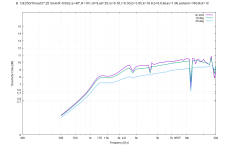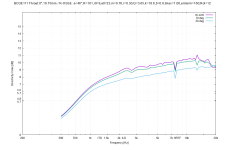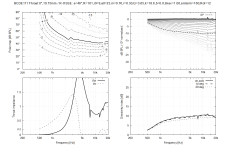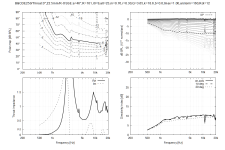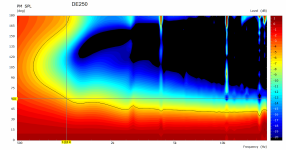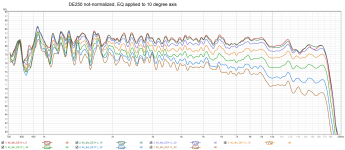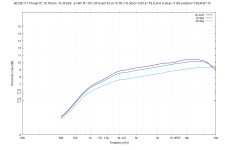I asked @Patrick Bateman to explain his design goals but failed to explain my own.
Waveguide design goals: 1) I wanted to keep the 10 degree and 20 degree lines similar between 2kHz and 10kHz but with a 1 to 1.5 dB difference in level to allow for multiple listeners in a home theater side by side seating listening position - speakers toed in. 2) I wanted the directivity to widen from the narrower waveguide control angle to 60 degrees from 2kHz to 1.2kHz (1.2kHz B&C recommended DE111 crossover point). 3) I didn't care about anything over 12kHz because I can't hear anything above that - I'm thinking I probably should have tried to widen directivity earlier than I did in order to increase SPL level between 10kHz to 12kHz on the listening angles to compensate for my hearing loss as it falls off. Or maybe not, I don't know.
My listening perception theory (I could be wrong): sound localization by sound level difference (ILD) is strongest above 2kHz and transitions to timing differences (ITD) below 1.5kHz with a "zone of confusion" between 1.5kHz and 2kHz. Therefore, widening directivity in the zone of confusion won't harm perception of sound localization. Also, increased reflections through the zone of confusion from between apprx. 1kHz to 2kHz helps humans improve our perception of clarity/intelligibility. That's why I used the 8 inch free standing waveguide, to widen quickly below 2kHz. The woofer portion of the speaker might help to create reflections useful for perception of clarity/intelligibility as well, I don't know. Widening below 2kHz also allows the perception of reverberance without harming sound localization. Finally, the level difference of 1 to 1.5dB between 10 degrees and 20/25 degrees off axis allows the speakers to be toed in for a wider localization sweet spot so you can sit side by side on a couch (home theater listening). I'm not sure the 1 to 1.5dB target is correct. Maybe you want to aim for a larger 2 or 3dB difference to give two listeners equal SPL between the front left and right speakers, therefore, a narrower waveguide coverage angle.
I'm fully aware my listening perception theory could be wrong so I welcome correction from anyone who offers. No one should follow what I did because I don't know what I'm doing. I certainly don't know anything about crossover design or woofer matching either.


Waveguide design goals: 1) I wanted to keep the 10 degree and 20 degree lines similar between 2kHz and 10kHz but with a 1 to 1.5 dB difference in level to allow for multiple listeners in a home theater side by side seating listening position - speakers toed in. 2) I wanted the directivity to widen from the narrower waveguide control angle to 60 degrees from 2kHz to 1.2kHz (1.2kHz B&C recommended DE111 crossover point). 3) I didn't care about anything over 12kHz because I can't hear anything above that - I'm thinking I probably should have tried to widen directivity earlier than I did in order to increase SPL level between 10kHz to 12kHz on the listening angles to compensate for my hearing loss as it falls off. Or maybe not, I don't know.
My listening perception theory (I could be wrong): sound localization by sound level difference (ILD) is strongest above 2kHz and transitions to timing differences (ITD) below 1.5kHz with a "zone of confusion" between 1.5kHz and 2kHz. Therefore, widening directivity in the zone of confusion won't harm perception of sound localization. Also, increased reflections through the zone of confusion from between apprx. 1kHz to 2kHz helps humans improve our perception of clarity/intelligibility. That's why I used the 8 inch free standing waveguide, to widen quickly below 2kHz. The woofer portion of the speaker might help to create reflections useful for perception of clarity/intelligibility as well, I don't know. Widening below 2kHz also allows the perception of reverberance without harming sound localization. Finally, the level difference of 1 to 1.5dB between 10 degrees and 20/25 degrees off axis allows the speakers to be toed in for a wider localization sweet spot so you can sit side by side on a couch (home theater listening). I'm not sure the 1 to 1.5dB target is correct. Maybe you want to aim for a larger 2 or 3dB difference to give two listeners equal SPL between the front left and right speakers, therefore, a narrower waveguide coverage angle.
I'm fully aware my listening perception theory could be wrong so I welcome correction from anyone who offers. No one should follow what I did because I don't know what I'm doing. I certainly don't know anything about crossover design or woofer matching either.
I'm not good at measuring yet but I wanted to see the difference between the DE250/DE111 waveguides and a Kali LP6, with the Kali normalized to 10 degrees like the ABEC simulations and the measurements I showed in post #12,736. I'm familiar with the ATH/ABEC simulation reports after working with them so comparing it with a known speaker will help me understand listening perception differences. When I get better at measuring I'll measure the Kali LP6 again to be more fair to the speaker. To my ear, the Kali sounds great even though it doesn't measure anywhere close to as well as the 3D printed R-OSSEs. Of course, the Kali is designed with a completely different coverage angle. So this isn't intended to criticize, it's only to learn and see the measurements in a format I'm familiar with.

R-OSSE

R-OSSE
That's my belief and why I look for as high a DI as feasible (it gets really hard to get very high DI in a small space.)Maybe you want to aim for a larger 2 or 3dB difference to give two listeners equal SPL between the front left and right speakers, therefore, a narrower waveguide coverage angle.
I do think that your "confusion zone" is badly named since there isn't really any "confusion," it's just that timing and intensity both play rolls.
To me, ITD being the most significant at LFs suggests that localization must be losing capability there, because the timing differences are so small compared to the period.
Thanks. That's good to know because I've seen people complain about some speaker brand names with narrow directivity. It made me worried about going too narrow. Now I can try to make a narrow waveguide.
I'll stop saying confusion zone. Maybe localization cue spectrum is better.
I'm not sure if I'm understanding the topic of localization correctly, but if ITD supersedes ILD below 1.5kHz what perceptual benefit do we gain by increasing directivity below 1.5kHz? Does a large diameter waveguide have less and less benefit for localization and start improving a different perception such as intelligibility; or a delayed wall reflection that improves the perception of reverberance? I've read people say they like the sound of large waveguides but I don't know what the waveguide is doing in terms of listening perception.
I'll stop saying confusion zone. Maybe localization cue spectrum is better.
I'm not sure if I'm understanding the topic of localization correctly, but if ITD supersedes ILD below 1.5kHz what perceptual benefit do we gain by increasing directivity below 1.5kHz? Does a large diameter waveguide have less and less benefit for localization and start improving a different perception such as intelligibility; or a delayed wall reflection that improves the perception of reverberance? I've read people say they like the sound of large waveguides but I don't know what the waveguide is doing in terms of listening perception.
It's a big help to be able to put the compression driver into a free standing simulation by modifying the nodes text file.


Attachments
It would be interesting to see both measurements non-normalized (the DE111 and DE250). The ducts of throat extensions create noticeable resonances seen in the impedance curves (which is known) but perhaps those don't create so big problems FR-wise, relatively easy to be flattened by an EQ. That would be a good thing, broading a possible use to a much wider range of drivers and situations.
Last edited:
Hi!...
That's good to know because I've seen people complain about some speaker brand names with narrow directivity. It made me worried about going too narrow. Now I can try to make a narrow waveguide.
...
there is important lesson here to learn from. I mean you have probably read even more people complaining about very wide coverage speakers, simply because there are plenty more.
We, as person reading feedback about various loudspeakers, should try to put the feedback into some context, first to theirs in order to be able to reflect it somehow to our own. For instance, there is no auditory input associated with text so we just cannot hear what they heard. Then 99%, if not 100% of context could be missing, like, what did one expect? how was the speakers positioned? in what kind of environment? did the writer have some other speakers? what is their exposure and expertise? Perhaps they heard best sound ever they just don't like it because it wasn't the thing they are used to, how much money was involved and so on, numerous things that could have affected the review and we just don't know.
Best thing one can do is try to come up a context and possible reasons for pros and cons, idea is try to get their perspective into things, asking, looking for earlier content and so on. But, to really figure out what works better in your situation with your expectations you just have to try few options you care about, listen how they affect sound and figure out which one works better for you. This is the only way to really gain experience and more knowledge on your context and your expectations and howbit might relate to others. Listen with thought, when you hear some phenomenon assume there is more to it than some single aspect you can associate it with and so on, explore, listen with curious mind 🙂 measure, test, compare, try, fail, and so on, learning process helps you forward. Could be long journey, remember to have fun! 🙂
Last edited:
I dug out an old textbook from -04, The Psychology of Hearing by Brian C.J. Moore, that you no doubt have, and this is what he says on page 266 under ‘Space Perceptions/ General Conclusions’:That's my belief and why I look for as high a DI as feasible (it gets really hard to get very high DI in a small space.)
I do think that your "confusion zone" is badly named since there isn't really any "confusion," it's just that timing and intensity both play rolls.
To me, ITD being the most significant at LFs suggests that localization must be losing capability there, because the timing differences are so small compared to the period.
“ For localization in the horizontal plane, the cues of interaural time nd intensity difference are most important. Interaural time is most useful at low frequencies, while interaural intensity is most useful at high frequencies. However transient sounds, or periodic sounds with low repetition rates, can be localized on the basis of interaural time delay even if they only contain high frequencies. For periodic sounds, the binaural system shows a form of adaptation; judgement of position in space depends mostly on the leading part of the sound and less on later parts. …
…Judgement of the location of a sound covering a restricted frequency range can be adversely affected by the presence of an interfering sound in a different frequency range, when the interfering sound provides conflicting binaural cues. “
Do you broadly agree with this?
The downside is that any quick widening or narrowing has a direct impact on power response as a function of frequency - it deviates it from being flat for flat direct sound (that's basically what the DI curve shows). It's not only about localization but also about the timbre/spectral neutrality. In general what we want is a gradual increase (if it cannot stay constant) of the directivity for this reason, as the power response is also an important factor in small rooms.[...] That's why I used the 8 inch free standing waveguide, to widen quickly below 2kHz.
And to maintain the directivity controlled low enough in frequency we just need big enough waveguides. I think that's also why they sound so good. Small waveguides are always a compromise, IMO, unless you want a very wide radiation pattern (i.e. a low DI overall).
Last edited:
Here are non-normalized for DE111 and DE250. I also included a non-normalized DE250 with EQ applied to the 10 degree axis then measured 0 to 60 degrees. I know others could do a lot better job EQing the DE250 than I did, I'll ask for help with that when the time comes. I'll also attach the REW MDAT files. It stopped raining so I'm going to make a lazy susan and take new measurements outside.It would be interesting to see both measurements non-normalized (the DE111 and DE250). The ducts of throat extensions create noticeable resonances seen in the impedance curves (which is known) but perhaps those don't create so big problems FR-wise, relatively easy to be flattened by an EQ. That would be a good thing, broading a possible use to a much wider range of drivers and situations.
Attachments
Last edited:
Maybe not as high as 1.5 kHz, but yes I certainly do believe that directivity becomes less relevant as the frequency falls.I'm not sure if I'm understanding the topic of localization correctly, but if ITD supersedes ILD below 1.5kHz what perceptual benefit do we gain by increasing directivity below 1.5kHz?
The ILD has to decrease with decreasing frequency because of head diffraction. Thus it is inevitable that at lower Freqs the ITD will be dominate.
A higher DI reduces the very early reflections (VER: reflections that are close in time such that they fuss with the direct sound.) This enhances imaging while not necessarily disturbs spaciousness (reverberation,) but this then depends on the room characteristics.Does a large diameter waveguide have less and less benefit for localization and start improving a different perception such as intelligibility; or a delayed wall reflection that improves the perception of reverberance?
Thanks! Those are fantastic results. When I first noticed the length of the throat extension for the DE250 I was little worried but this proves it's no issue.Here are non-normalized for DE111 and DE250.
I suspect that the resolution is still a little decreased due to the time window (so it won't be actually this smooth) but these results seem already better than with the raw drivers.
I did not see resonances on a DE250 due to its throat on my systems.The ducts of throat extensions create noticeable resonances seen in the impedance curves (which is known)
This is my belief, which is why I set objective accuracy (as opposed to subjective preference) as my goal. This way my experiential expectations are as close to accuracy as possible.Perhaps they heard best sound ever they just don't like it because it wasn't the thing they are used to
I would take anything that Brian Moore said very seriously and I do agree with the above. Especially the last sentence about "judgement of the location" as a critical point. VER are an "interfering sound" and as such they degrade imaging. High DI minimizes this issue. But remember that our sensitivity to VER will decrease with frequency because the time for fusion becomes shorter. This means, in essence, that imaging will be a dominantly mid/high frequency (1-5 kHz) transient effect.I dug out an old textbook from -04, The Psychology of Hearing by Brian C.J. Moore, that you no doubt have, and this is what he says on page 266 under ‘Space Perceptions/ General Conclusions’:
“ For localization in the horizontal plane, the cues of interaural time nd intensity difference are most important. Interaural time is most useful at low frequencies, while interaural intensity is most useful at high frequencies. However transient sounds, or periodic sounds with low repetition rates, can be localized on the basis of interaural time delay even if they only contain high frequencies. For periodic sounds, the binaural system shows a form of adaptation; judgement of position in space depends mostly on the leading part of the sound and less on later parts. …
…Judgement of the location of a sound covering a restricted frequency range can be adversely affected by the presence of an interfering sound in a different frequency range, when the interfering sound provides conflicting binaural cues. “
Do you broadly agree with this?
Agreed!Small waveguides are always a compromise, IMO, unless you want a very wide radiation pattern (i.e. a low DI overall).
But this is a bit different situation. A ring plug was used here, starting at the phase plug exit inside the driver (⌀19mm), extending it by a straight tube 22.5 mm long. Then the WG starts with a sharp edge -I did not see resonances on a DE250 due to its throat on my systems.
(The red line P1-P135 represents the phase plug exit).
How low in frequency do you think is good to control with the waveguide? I have a completely untrained ear and I've never heard large waveguides, let alone R-OSSE (excluding the sweeps). In my case, I targeted control to 2kHz then intentionally stopped due to my incorrect theory of sound perception.
Attachments
Another question I have, if we increase DI as high as we can we'll have a sharper dropoff down to where a woofer takes over. Is there a way to compensate for a high DI waveguide handing off to a lower DI woofer?
^ I wouldn't argue that holding a high DI as low as possible was not a good thing, but I certainly believe that it becomes less and less important as the frequency falls. I targeted about 500 Hz as a good "practical" limit.
- Home
- Loudspeakers
- Multi-Way
- Acoustic Horn Design – The Easy Way (Ath4)
